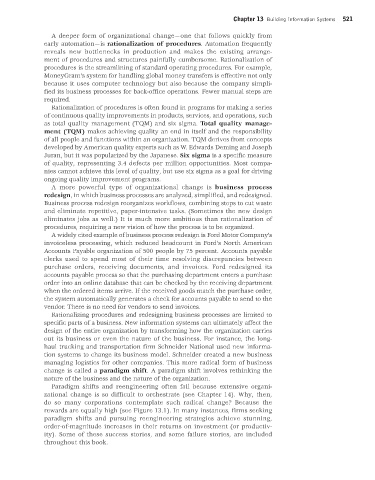Page 522 -
P. 522
Chapter 13 Building Information Systems 521
A deeper form of organizational change—one that follows quickly from
early automation—is rationalization of procedures. Automation frequently
reveals new bottlenecks in production and makes the existing arrange-
ment of procedures and structures painfully cumbersome. Rationalization of
procedures is the streamlining of standard operating procedures. For example,
MoneyGram's system for handling global money transfers is effective not only
because it uses computer technology but also because the company simpli-
fied its business processes for back-office operations. Fewer manual steps are
required.
Rationalization of procedures is often found in programs for making a series
of continuous quality improvements in products, services, and operations, such
as total quality management (TQM) and six sigma. Total quality manage-
ment (TQM) makes achieving quality an end in itself and the responsibility
of all people and functions within an organization. TQM derives from concepts
developed by American quality experts such as W. Edwards Deming and Joseph
Juran, but it was popularized by the Japanese. Six sigma is a specific measure
of quality, representing 3.4 defects per million opportunities. Most compa-
nies cannot achieve this level of quality, but use six sigma as a goal for driving
ongoing quality improvement programs.
A more powerful type of organizational change is business process
redesign, in which business processes are analyzed, simplified, and redesigned.
Business process redesign reorganizes workflows, combining steps to cut waste
and eliminate repetitive, paper-intensive tasks. (Sometimes the new design
eliminates jobs as well.) It is much more ambitious than rationalization of
procedures, requiring a new vision of how the process is to be organized.
A widely cited example of business process redesign is Ford Motor Company’s
invoiceless processing, which reduced headcount in Ford’s North American
Accounts Payable organization of 500 people by 75 percent. Accounts payable
clerks used to spend most of their time resolving discrepancies between
purchase orders, receiving documents, and invoices. Ford redesigned its
accounts payable process so that the purchasing department enters a purchase
order into an online database that can be checked by the receiving department
when the ordered items arrive. If the received goods match the purchase order,
the system automatically generates a check for accounts payable to send to the
vendor. There is no need for vendors to send invoices.
Rationalizing procedures and redesigning business processes are limited to
specific parts of a business. New information systems can ultimately affect the
design of the entire organization by transforming how the organization carries
out its business or even the nature of the business. For instance, the long-
haul trucking and transportation firm Schneider National used new informa-
tion systems to change its business model. Schneider created a new business
managing logistics for other companies. This more radical form of business
change is called a paradigm shift. A paradigm shift involves rethinking the
nature of the business and the nature of the organization.
Paradigm shifts and reengineering often fail because extensive organi-
zational change is so difficult to orchestrate (see Chapter 14). Why, then,
do so many corporations contemplate such radical change? Because the
rewards are equally high (see Figure 13.1). In many instances, firms seeking
paradigm shifts and pursuing reengineering strategies achieve stunning,
order-of- magnitude increases in their returns on investment (or productiv-
ity). Some of these success stories, and some failure stories, are included
throughout this book.
MIS_13_Ch_13 global.indd 521 1/17/2013 2:31:21 PM

